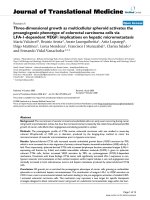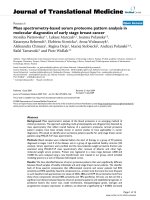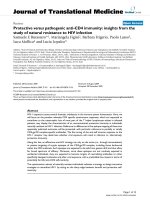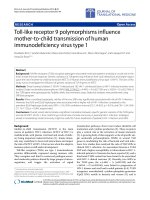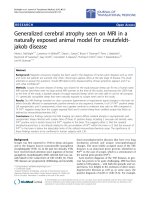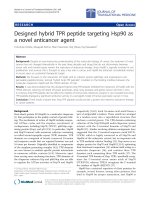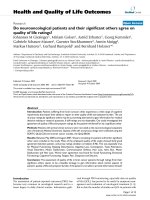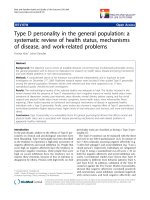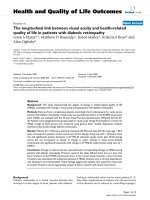báo cáo hóa học: " Simulator sickness when performing gaze shifts within a wide field of view optic flow environment: preliminary evidence for using virtual reality in vestibular rehabilitation" pptx
Bạn đang xem bản rút gọn của tài liệu. Xem và tải ngay bản đầy đủ của tài liệu tại đây (789.77 KB, 10 trang )
BioMed Central
Page 1 of 10
(page number not for citation purposes)
Journal of NeuroEngineering and
Rehabilitation
Open Access
Research
Simulator sickness when performing gaze shifts within a wide field
of view optic flow environment: preliminary evidence for using
virtual reality in vestibular rehabilitation
Patrick J Sparto*
1,2,3
, Susan L Whitney
1,2
, Larry F Hodges
4
,
Joseph M Furman
1,2,3
and Mark S Redfern
2,3
Address:
1
Department of Physical Therapy, University of Pittsburgh, Pittsburgh, PA, USA,
2
Department of Otolaryngology, University of
Pittsburgh, Pittsburgh, PA, USA,
3
Department of BioEngineering, University of Pittsburgh, Pittsburgh, PA, USA and
4
Department of Computer
Science, University of North Carolina-Charlotte, Charlotte, NC, USA
Email: Patrick J Sparto* - ; Susan L Whitney - ; Larry F Hodges - ;
Joseph M Furman - ; Mark S Redfern -
* Corresponding author
VRbalancephysical therapyvirtual environmentCAVE
Abstract
Background: Wide field of view virtual environments offer some unique features that may be
beneficial for use in vestibular rehabilitation. For one, optic flow information extracted from the
periphery may be critical for recalibrating the sensory processes used by people with vestibular
disorders. However, wide FOV devices also have been found to result in greater simulator sickness.
Before a wide FOV device can be used in a clinical setting, its safety must be demonstrated.
Methods: Symptoms of simulator sickness were recorded by 9 healthy adult subjects after they
performed gaze shifting tasks to locate targets superimposed on an optic flow background. Subjects
performed 8 trials of gaze shifting on each of the six separate visits.
Results: The incidence of symptoms of simulator sickness while subjects performed gaze shifts in
an optic flow environment was lower than the average reported incidence for flight simulators. The
incidence was greater during the first visit compared with subsequent visits. Furthermore, the
incidence showed an increasing trend over the 8 trials.
Conclusion: The performance of head unrestrained gaze shifts in a wide FOV optic flow
environment is tolerated well by healthy subjects. This finding provides rationale for testing these
environments in people with vestibular disorders, and supports the concept of using wide FOV
virtual reality for vestibular rehabilitation.
Background
One out of three elderly persons and more than one out
of five working adults report dizziness[1,2]. There is a
growing body of literature that suggests that persons with
dizziness due to vestibular disorders fall, regardless of age
[3]. Falls in persons with vestibular disorders have
Published: 23 December 2004
Journal of NeuroEngineering and Rehabilitation 2004, 1:14 doi:10.1186/1743-0003-1-14
Received: 29 November 2004
Accepted: 23 December 2004
This article is available from: />© 2004 Sparto et al; licensee BioMed Central Ltd.
This is an Open Access article distributed under the terms of the Creative Commons Attribution License ( />),
which permits unrestricted use, distribution, and reproduction in any medium, provided the original work is properly cited.
Journal of NeuroEngineering and Rehabilitation 2004, 1:14 />Page 2 of 10
(page number not for citation purposes)
potentially catastrophic consequences[4]. Thus, develop-
ment of rehabilitation methodologies that can improve
balance could have a great impact on public health.
The use of virtual reality (VR) has been explored in many
areas of physical and mental rehabilitation [5-8]. Viirre
[9,10] and Kramer et al. [11] were the first to discuss the
use of VR with persons with vestibular disorders. The the-
oretical basis for using VR in the treatment of vestibular
disorders is two-fold. First, persons with peripheral vestib-
ular disorders have disequilibrium and complain of visual
blurring [12]. These common symptoms may be caused
by abnormalities in the vestibulo-ocular reflex (VOR) gain
during head movements. Functional recovery of the VOR
requires both visual inputs and movements of the head
and body [13]. Retinal slip, i.e. movement of a visual
image across the retina, is a powerful signal that can
induce adaptation of vestibular responses [14]. If care is
taken to minimize delays between head tracking devices
and image updates, VR-induced retinal slip can be deliv-
ered in a controlled manner in order to cause adaptation.
A randomized trial has demonstrated that persons with
uncompensated peripheral vestibular disorders can
improve with vestibular rehabilitation directed at induc-
ing retinal slip [15]. People can also adapt to vestibular
injuries through movement. Shepard et al. were able to
reduce symptoms in 87% of patients who had chronic
unilateral peripheral vestibular loss for at least 2 months
[16]. Therefore, exposure to visual experiences and move-
ment are key to the functional recovery of persons with
vestibular disorders.
Secondly, people with vestibular disorders complain of
what has been called "space and motion discomfort"
(SMD) and "visual vertigo" [17,18]. Situations that have
been reported to precipitate SMD or visual vertigo
include: walking in supermarket aisles or shopping malls,
movement in cars and trains, long visual distances, or
complex and confusing visual stimuli. Consequently, VR
could allow persons with vestibular disorders to experi-
ence graded exposure to symptom-provoking situations
in a controlled environment. Using VR for exposure ther-
apy has a well-established foundation in the treatment of
specific phobias (e.g. fear of heights) [8,19].
Wide field of view (FOV), screen-based projection devices
(or spatially immersive displays) originated with the
CAVE™ at the University of Illinois in Chicago [20].
Although the space required and cost make these systems
impractical for clinical use, their wide FOV allow research
laboratories to investigate how different motion cues
affect balance and vestibular rehabilitation. One advan-
tage of wide FOV devices is their ability to provide motion
cues in the periphery, which can result in a greater sense
of vection, or self-movement, compared with more lim-
ited FOV devices [21]. We believe that these factors may
provide a substantial benefit compared with narrower
FOV devices such as HMDs in the treatment of vestibular
disorders. However, the wide FOV devices have also been
associated with greater reports of simulator sickness [22].
Thus, while a wide FOV is desirable from a theoretical
standpoint because a greater perception of motion occurs
in the periphery, this same factor may elevate levels of
simulator sickness and may be cause for discontinuing a
treatment.
The primary purpose of this paper is to present prelimi-
nary evidence for the ability of subjects to tolerate gaze
shifting while situated in a wide FOV optic flow environ-
ment. We will demonstrate that healthy subjects were able
to tolerate the environments without having a large inci-
dence in simulator sickness. The incidence of simulator
sickness depended strongly on how much experience the
subjects had in the environment, and weakly on the dura-
tion of exposure within each visit.
Methods
Subjects
Nine adults (22–75 years, mean ± S.D. 39 ± 19 yrs) with
no history of vestibular system pathology participated
after providing informed consent. Subjects had a visual
acuity of 0.3 LogMAR units or better without using correc-
tive lenses, and contrast sensitivity greater than 1.8 (Pelli-
Robson Contrast Sensitivity). The protocol was approved
by the University of Pittsburgh Institutional Review
Board.
Equipment
The Balance NAVE Automatic Virtual Environment
(BNAVE), a wide field of view projection-based immersive
display system, was developed to investigate the multi-
sensory interactions in postural control [23]. Three 2.4 m
× 1.8 m (vertical × horizontal) back-projected screens are
arranged as shown in Figure 1. The side screens make an
included angle of 110° with the front screen. The front
screen is 1.5 m from the user, and the opening of the
BNAVE at the location of the subject is approximately 2.9
m. The images are displayed using Epson 810p PowerLite
LCD monoscopic projectors, with a pixel resolution of
1024 × 768 for each screen. Each projector is connected to
an NVIDIA GeForce4 graphics processing unit (64 MB tex-
ture memory) installed in a separate PC (Pentium, 2.2
GHz, 512 MB RAM) running Windows 2000. The move-
ment of the images on the three PCs is synchronized and
controlled by a server via a local area network. The update
rate of the images is consistently at least 30 frames per
second.
Several environments can be used for vestibular rehabili-
tation. One environment produces optic flow through the
Journal of NeuroEngineering and Rehabilitation 2004, 1:14 />Page 3 of 10
(page number not for citation purposes)
use of moving geometric patterns such as stripes or
squares of alternating colors. Scene characteristics such as
the spatial frequency, contrast, direction and speed of
movement can all be independently prescribed. Further-
more, targets can be inserted into the environment that
subjects are requested to look at. Consequently, for vestib-
ular rehabilitation, we can ask a patient to perform unre-
strained head gaze shifts to acquire moving targets while
a background of moving stripes is moving past the
patient, simulating the functional task of looking for a
product while moving down the aisle of a grocery store. A
virtual grocery store has also been developed (Figure 2).
This environment contains several aisles, each with a dif-
ferent product theme. The dimensions of the aisle (width
and length) are adjustable. Scene complexity can be
altered by increasing the number of items on the shelves.
The objects within the environment have both software-
generated and photographic texture maps. In both envi-
ronments, the task difficulty can be modified by varying
the scene characteristics, thus exposing the patient to
symptom-producing situations in a controlled and graded
manner. In each environment, three-dimensional models
were created using 3D Studio Max. Although the projec-
tors used were not stereoscopic, a strong illusion of depth
was elicited based on monocular depth cues such as per-
spective projection. The location of the eyepoint used for
the perspective projection was based upon a fixed stance
location in the horizontal plane and the subject's eye
height. In addition, although head-tracked perspective
correction was not used in the current application, this
Experimental set-up for Task H, Visit 1 (see Tables 1 and 2 for explanation)Figure 1
Experimental set-up for Task H, Visit 1 (see Tables 1 and 2 for explanation). Subjects stood upright on force platform and per-
formed gaze shifts while target moved on a solid background. The target moved every 3 to 6 seconds from positions 1 to 4,
located 40 to 50 degrees from midline.
Journal of NeuroEngineering and Rehabilitation 2004, 1:14 />Page 4 of 10
(page number not for citation purposes)
Virtual Grocery Store developed for providing exposure therapy for patients with dizziness that is increased in similar environmentsFigure 2
Virtual Grocery Store developed for providing exposure therapy for patients with dizziness that is increased in similar environ-
ments. Aisle length, shelf height, the number of products on the shelves, and object textures can all be manipulated depending
on the goal of the therapy session.
Journal of NeuroEngineering and Rehabilitation 2004, 1:14 />Page 5 of 10
(page number not for citation purposes)
capability is possible and fully functional using a Pol-
hemus Fastrak position tracking system (Polhemus, Inc.
Colchester, VT).
Procedure
The ability of subjects to perform gaze shifts in response
to moving targets superimposed on both static and mov-
ing backgrounds was examined. Eight different gaze tasks
are performed on each visit (Table 1). Each gaze task was
performed for 90 s with alternating movements to the left
and right every 3 to 6 seconds (except for tasks B, F, H).
Each task was performed with the six different back-
grounds (Table 2). Each background condition was per-
formed on a different visit. Background conditions 1 and
2 did not have optic flow and thus served as a control con-
ditions for the remaining 4 backgrounds, which were ran-
domized over the next 4 visits. During the high contrast
conditions, the luminance of the stripes was 1 and 170 cd/
m
2
, respectively. During the low contrast conditions, the
luminance of the stripes was 15 and 34 cd/m
2
. The low
contrast condition was based on average measurements of
luminance obtained from products sampled at a local gro-
cery store, using a luminance meter (LS-100 Luminance
Light Meter, Minolta Corp. Ramsey, NJ). The spatial fre-
quencies were set according to common sizes of soup cans
(high, 4.2 cycles/meter) and cereal boxes (low, 1.4 cycles/
meter) found in the local grocery store. The simulated
velocity of the optic flow was 0.5 m/s. The central 25° of
the display was masked by a solid region with a lumi-
nance of 15 cd/m
2
in order to avoid aliasing in the display
as the stripes became smaller in the distance.
Rests of 3 minutes were provided after each task, during
which Subjective Units of Discomfort (SUDS, 0–10 range)
was rated and the Simulator Sickness Questionnaire
(SSQ) was completed [24]. The SSQ contains 16 items on
which subjects rate the degree of severity on a 4-item scale
(0 = none, 1 = slight, 2 = moderate, 3 = severe). A total
score is computed along with 3 subscales – nausea (gen-
eral discomfort, increased salivation, sweating, nausea,
difficulty concentrating, stomach awareness, burping),
oculomotor stress (general discomfort, fatigue, headache,
eyestrain, difficulty focusing, difficulty concentrating,
blurred vision), and disorientation (difficulty focusing,
nausea, head fullness, blurred vision, dizzy: eyes open,
dizzy: eyes closed, vertigo). Furthermore, pulse and blood
pressure was monitored after every trial using an auto-
matic device. Initial recordings of each of the measures
Table 1: Gaze tasks performed on each of the six visits. On trials 3 to 8, the order of tasks D, E, F, G, H, and I are randomized on each
visit.
Trial Task
0 A) Initial reading
1 B) 10 deg head saccades to the right – calibration of head sensor
2 C) Control task – no head or eye movements
3 D) Head center, Eye saccades to ± 10 deg
4 E) Head left 50 deg, Eye saccades to ± 10 deg
5 F) Head right 50 deg, Eye saccades to ± 10 deg
6 G) Gaze stabilization during sinusoidal head movement at 0.25 Hz (VOR)
7 H) Gaze saccades to ± 40 and ± 50 deg from midline
8 I) Smooth pursuit to left between 10 – 60 deg, followed by smooth pursuit to right between 10 – 60 deg
Table 2: Background conditions for each of the six visits. On visits 3 to 6, the order of conditions C, D, E, and F are randomized.
Visit Condition Optic Flow Contrast Spatial Frequency
1 A No None None
2 B No High Low
3CYesLowLow
4DYesLowHigh
5EYesHighLow
6 F Yes High High
Journal of NeuroEngineering and Rehabilitation 2004, 1:14 />Page 6 of 10
(page number not for citation purposes)
were also recorded prior to exposure. During each trial,
postural sway was recorded using a force platform and 6
degrees of freedom electromagnetic trackers placed on the
head and waist (Polhemus Fastrak, Colchester, VT). The
accuracy of the trackers is 0.8 mm in translation and 0.15°
in rotation, and the stated resolution of 0.2 mm in trans-
lation and 0.025° in orientation. The trackers have a
latency of 4 ms and were digitized at 20 Hz. The horizon-
tal and vertical eye movements were measured using
video-oculography (VOG, Figure 3). The VOG device
(Micromedical, Chatham, IL) was fastened using an
adjustable helmet insert and contained see-through dich-
roic glass that reflected images of the eyes up to infrared
cameras. The accuracy of the VOG is 0.3 deg and the
images are captured at 60 Hz. Using the sampling rates of
the tracker and VOG, the maximum delay between record-
ing simultaneous movements of both the head and eye
would be 33 ms. The head and eye movements were cali-
brated using targets placed in known locations. Eye-in-
head position is combined with head-in-space position to
yield continuous gaze position (eye-in-space). The timing
and accuracy of the head gaze movements with respect to
the targets will be the subject of a future report.
Data Analysis
Five dependent variables of interest were examined:
SUDS, total SSQ, and 3 SSQ subscales. The three subscales
of the SSQ were computed by summing the scores for the
component items of each subscale, and multiplying by an
appropriate weighting factor (9.54 for Nausea, 7.58 for
Oculomotor, and 13.92 for Disorientation) [24]. The
total SSQ score was equal to the sum of the 3 subscales,
multiplied by 3.7. Histograms of each dependent variable
were plotted according visit number (1 to 6) and trial
number (0 to 8). After observing that the data were not
normally distributed due to a large majority of 0
responses and the presence of long tails, we tabulated the
frequency of non-zero responses for each dependent vari-
able. The effect of visit number and trial number on the
frequency of non-zero responses was evaluated using χ
2
statistics. Because of the large number of comparisons (5
dependent variables × 2 main effects), the significance
level was set at α = 0.05/10 = 0.005.
Results
Gaze shifts performed by one subject in response to tar-
gets moving at least 80° in the yaw plane (Task G) are
shown in Figure 4. These gaze shifts are combinations of
head and eye movements. The top plot demonstrates the
target-in-space yaw position (T), head-in-space yaw posi-
tion (H), and eye-in-head yaw position (E). The last two
quantities are combined to produce the gaze position (G)
shown in the bottom plot. In this example, it can be seen
that the eye and head movements effectively combine to
allow the person to look at the desired target position.
Analytical techniques will allow us to quantify head and
eye coordination strategies in persons with vestibular
disorders, both in optic flow fields and more complex
environments.
The tolerance of the subjects to the gaze shifts was
assessed using Subjective Units of Discomfort (SUDS) and
the Simulator Sickness Questionnaire (SSQ). For each of
the measures, the majority of the responses were zero.
Therefore, each of the measures was converted into a
binary scale consisting of responses equal to zero or
greater than zero. The SUDS rating was greater than zero
Video-oculography (VOG) see-through goggles used to measure eye-in-head position in the vertical and horizontal planesFigure 3
Video-oculography (VOG) see-through goggles used to
measure eye-in-head position in the vertical and horizontal
planes. Subject also wore 6 degrees of freedom electromag-
netic tracker on top of his head to measure head in space
position. Both signals are combined to obtain gaze, or eye
gaze-in-space position.
Journal of NeuroEngineering and Rehabilitation 2004, 1:14 />Page 7 of 10
(page number not for citation purposes)
only 25% of the time. For each of the SSQ subscales, a
score greater than 0 was given if any of the 7 component
items for the subscale was rated greater than 0. The
SSQ:Oculomotor subscale had the most non-zero
responses, at 29%. The SSQ:Nausea and SSQ:Disorienta-
tion subscales had 12% and 5% non-zero responses,
respectively. Overall, the SSQ-Total had 31% non-zero
responses.
The effect of visit number and trial number on the fre-
quency of non-zero responses was examined using χ
2
sta-
tistics. The effect of visit number was significant for SUDS,
SSQ:Nausea, SSQ:Oculomotor, and SSQ:Total (Table 3).
The most obvious finding was that the number of non-
zero responses was significantly greater the first visit. The
effect of trial number was not significant for all measures
(Table 4).
Discussion
The ability to perform coordinated gaze movements
within an optic flow environment may lead to the devel-
opment of tools to improve outcomes in vestibular reha-
bilitation. The current research represents the first attempt
to assess self-reported tolerance to these movements in a
wide field of view environment. The ratings indicate that
on a majority of the trials, this group of healthy subjects
experienced no discomfort and simulator sickness while
performing 8 different types of gaze movements under
different optic flow conditions. On 75% of the trials, sub-
jects reported no subjective discomfort. On 69% of the tri-
als subjects reported no symptoms of simulator sickness.
Although there is no data with which to compare the inci-
dence of symptoms during performance of coordinated
eye and head movements in an optic flow environment,
we have chosen to review the data obtained from flight
Gaze shifts during Task H obtained from 1 subjectFigure 4
Gaze shifts during Task H obtained from 1 subject. Top: target yaw position (T), head-in-space yaw position (H), and eye-in-
head yaw position (E). Bottom: target yaw position (T), and eye gaze-in-space yaw position (G).
Journal of NeuroEngineering and Rehabilitation 2004, 1:14 />Page 8 of 10
(page number not for citation purposes)
simulators and head mounted display units. The inci-
dence of symptoms in the current study is at the lower end
of the range relative to the previous flight simulator based
studies. For example, the incidence of simulator sickness
in this military pilots has ranged from 6–62%, depending
on the type of simulator [25]. The incidence of simulator
sickness after VR exposure in non-pilots is slightly greater;
approximately 60 to 80% of subjects report symptoms of
eyestrain, headache, nausea, and malaise after only 10–20
minutes [26,27]. The decreased incidence of problems
may be related to several factors. For one, the within trial
exposure time was short, approximately 90 seconds.
Therefore the total exposure time was only about 12 min-
utes, which is on the lower end of reported exposures
described in the literature [26,28]. Secondly, significant
rest breaks were provided between trials. The incorpora-
tion of rest breaks to reduce simulator sickness has not
been studied well. Thus, the type of display device, as well
as the content and nature of the task may have an effect on
the amount of sickness. Thus, although the current results
are not directly comparable to the previous research, they
will serve as a foundation for future work that examines
the incidence of symptoms while performing coordinated
eye and head movement tasks within a virtual grocery
store, or using a head mounted display.
There was a significant effect of visit number of the
number of non-zero responses. Analysis of the data
revealed that subjects appeared to have greater levels of
discomfort and symptoms of simulator sickness on the
first visit. It is possible that subjects had greater levels of
discomfort due to their lack of prior exposure to the
environment/experiment. Furthermore, our data is con-
sistent with findings from other studies that subsequent
Table 3: Incidence of non-zero responses for the self-reported Subjective Units of Discomfort SUDS) and Simulator Sickness
Questionnaire (SSQ) subscales and total score, as a function of visit number. Mean incidence, χ
2
test of association, and p value are also
provided. * indicates significant effect of visit number.
Visit SUDS SSQ:Nausea SSQ:Oculomotor SSQ:Disorientation SSQ:Total
1 352756956
2 381133033
3 221126528
4 2516191026
5 19026127
6 10814814
Mean 25 12 29 5 31
χ
2
17.9 25.2 30.7 10.1 25.3
p-value .003* <.001* <.001* .072 <.001*
Table 4: Incidence of non-zero responses for the self-reported Subjective Units of Discomfort (SUDS) and Simulator Sickness
Questionnaire (SSQ) subscales and total score, as a function of trial number. Mean incidence, χ
2
test of association, and p value are also
provided. No significant effect of trial number was found.
Trial SUDS SSQ:Nausea SSQ:Oculomotor SSQ:Disorientation SSQ:Total
0 (initial) 4 7 11 0 11
1 17615215
2 249241131
3 281328230
4 301331633
5 261535637
6 301539741
7 321538840
8 341740840
Mean 25 12 29 5 31
χ
2
15.0 5.2 16.0 8.0 16.2
p-value .06 .73 .04 .43 .04
Journal of NeuroEngineering and Rehabilitation 2004, 1:14 />Page 9 of 10
(page number not for citation purposes)
exposures to environments result in lower simulator sick-
ness [26,28]. Interpretation of this finding is clouded by
the confounding effect of the background displayed dur-
ing visit 1. During the first visit, the subjects always expe-
rienced movement of targets superimposed on a solid
background without optic flow. The experiment was
designed in this way because we assumed that this back-
ground would elicit the least amount of symptoms, and
would serve as a suitable background for subjects to learn
the movements. Consequently, the finding of decreased
tolerance to the movements during the first visit was
unexpected. Unfortunately, we are not able to distinguish
if the increased discomfort and simulator sickness was
due to the subject's inexperience with the environment or
due to the type of background.
We did not find a significant effect of trial number on the
number of non-zero responses to SUDS and the SSQ.
However, it was apparent that there was a trend for greater
number of non-zero responses as trial number increased
for the SUDS, SSQ:Oculomotor, and SSQ:Total Severity.
In previous reports using flight simulators, the level of
simulator sickness increased as the duration of exposure
increased [28]. Moreover, symptoms tended to persist
after the simulation was finished [25,29]. Addition of
more subjects may reveal the trial effect to be significant.
Nonetheless, the short duration of exposure within each
trial (i.e. 90 seconds) and the amount of rest provided to
the subjects between trials (i.e. 3 minutes) may have amel-
iorated the development of symptoms as the trials
accumulated.
The SSQ:Oculomotor subscale had the greatest number of
non-zero responses. Usually, this subscale is elevated sec-
ondary to the effects of using a head-mounted display
(HMD) device. HMD users frequently suffer from eye-
strain, and blurred vision and short-term changes in bin-
ocular vision possibly due to alterations in the balance
between the vergence and accommodation systems
[30,31]. In our case, we attribute the scores to the video-
oculography (VOG) device. Several subjects commented
that the VOG caused eyestrain. Furthermore, some sub-
jects reported that the dichroic lenses interfered with their
viewing of the environment. We intend to examine if
using electro-oculography (EOG), which measures eye
movements via surface electrodes surrounding the eyes,
will reduce the amount of oculomotor symptoms.
The ability to move one's head and search for targets is a
functional task that is often impaired in people with ves-
tibular disorders. In vestibular rehabilitation, patients are
encouraged to move their head during daily activities
because movement is needed for adaptation and
reweighting of the sensory signals. Using optic flow and/
or virtual environments, this activity could be restored.
Our preliminary analysis demonstrates that healthy peo-
ple are able to coordinate their head and eye movements
in the presence of stationary and moving backgrounds
with few side effects. The next step is to perform similar
experiments with people who have vestibular disorders.
In addition, it is imperative to study if these movements
can be tolerated while using narrower FOV HMDs. Head
mounted displays will most likely be the desired display
system of choice for vestibular rehabilitation because of
the relatively modest cost and high portability. However,
there are other characteristics of the display systems that
need to be considered. For example, it is common for
users of HMDs to complain of eyestrain, blurred vision,
headache, and nausea [30,31]. In addition, DiZio and
Lackner suggest that wearing an HMD effectively increases
the mass and inertia of the head, thereby leading to a sen-
sory rearrangement that may have some part in simulator
sickness [32]. This theory is supported by the work of
Howarth and Finch, who examined the amount of nausea
generated while subjects wore an HMD under 2 condi-
tions [33]. In one, subjects changed heading by using a
handheld input device. In the other, subjects changed
heading by rotating their head. Nausea was significantly
greater when subjects navigated using their head. The lag
between head movement and scene movement, and the
variability in frame update rate has also been considered
to play an important role in generating sickness with the
use of HMDs [26,33]. However, as head tracking technol-
ogy has improved, and update lags have been reduced,
this factor is probably not as important as it once was.
Thus, research on the use of HMDs in people with vestib-
ular disorders is necessary to determine if they can be
safely used in this population.
Conclusion
The performance of head unrestrained gaze shifts in a
wide FOV optic flow environment is tolerated well by
healthy subjects. This finding provides rationale for
testing these environments in people with vestibular
disorders, and supports the concept of using wide FOV
virtual reality for vestibular rehabilitation.
Acknowledgments
This research was supported in part by funding from the National Institutes
of Health (P30DC005205, R21DC005372, K23DC005384, and
K25AG001049) and the Eye and Ear Foundation. The authors gratefully
acknowledge assistance from Sabarish Babu, Jeffrey Jacobson, and Leigh
Mahoney
References
1. Grimby A, Rosenhall U: Health-related quality of life and dizzi-
ness in old age.[see comment]. Gerontology 1995, 41(5):286-298.
2. Yardley L, Owen N, Nazareth I, Luxon L: Prevalence and presen-
tation of dizziness in a general practice community sample
of working age people.[see comment]. Br J Gen Pract 1998,
48(429):1131-1135.
Publish with BioMed Central and every
scientist can read your work free of charge
"BioMed Central will be the most significant development for
disseminating the results of biomedical research in our lifetime."
Sir Paul Nurse, Cancer Research UK
Your research papers will be:
available free of charge to the entire biomedical community
peer reviewed and published immediately upon acceptance
cited in PubMed and archived on PubMed Central
yours — you keep the copyright
Submit your manuscript here:
/>BioMedcentral
Journal of NeuroEngineering and Rehabilitation 2004, 1:14 />Page 10 of 10
(page number not for citation purposes)
3. Whitney SL, Hudak MT, Marchetti GF: The dynamic gait index
relates to self-reported fall history in individuals with vestib-
ular dysfunction. J Vestib Res 2000, 10:99-105.
4. Tinetti ME, Williams CS: The effect of falls and fall injuries on
functioning in community-dwelling older persons. Journals of
Gerontology Series A, Biological Sciences & Medical Sciences 1998,
53(2):M112-119.
5. Sveistrup H, McComas J, Thornton M, Marshall S, Finestone H,
McCormick A, Babulic K, Mayhew A: Experimental studies of vir-
tual reality-delivered compared to conventional exercise
programs for rehabilitation. Cyberpsychol Behav 2003,
6(3):245-249.
6. Merians AS, Jack D, Boian R, Tremaine M, Burdea GC, Adamovich SV,
Recce M, Poizner H: Virtual reality-augmented rehabilitation
for patients following stroke. Phys Ther 2002, 82(9):898-915.
7. Girone M, Burdea G, Bouzit M, Popescu V, Deutsch JE: Orthopedic
rehabilitation using the "Rutgers ankle" interface. Studies in
Health Technology & Informatics 2000, 70:89-95.
8. Rothbaum BO, Hodges LF, Kooper R, Opdyke D, Williford JS, North
M: Effectiveness of computer-generated (virtual reality)
graded exposure in the treatment of acrophobia. Am J
Psychiatry 1995, 152(4):626-628.
9. Viirre E: Vestibular telemedicine and rehabilitation. Applica-
tions for virtual reality. Studies in Health Technology & Informatics
1996, 29:299-305.
10. Viirre E, Draper M, Gailey C, Miller D, Furness T: Adaptation of the
VOR in patients with low VOR gains. J Vestib Res 1998,
8(4):331-334.
11. Kramer PD, Roberts DC, Shelhamer M, Zee DS: A versatile stere-
oscopic visual display system for vestibular and oculomotor
research. J Vestib Res 1998, 8(5):363-379.
12. Herdman SJ, Whitney SL: Treatment of vestibular hypofunction.
In In: Vestibular Rehabilitation 2nd edition. Edited by: Herdman SJ. Phil-
adelphia: FA Davis Company; 1999:387-423.
13. Fetter M, Zee DS: Recovery from unilateral labyrinthectomy in
rhesus monkey. J Neurophysiol 1988, 59(2):370-393.
14. Miles FA, Eighmy BB: Long-term adaptive changes in primate
vestibuloocular reflex. I. Behavioral observations. J
Neurophysiol 1980, 43(5):1406-1425.
15. Pavlou M, Lingeswaran A, Davies RA, Gresty MA, Bronstein AM:
Machine-based vs. customized rehabilitation for the treat-
ment of chronic vestibular disorders. In ISPG Symposium Maas-
trict, The Netherlands 2001.
16. Shepard NT, Telian SA, Smith-Wheelock M: Habituation and bal-
ance retraining therapy. A retrospective review. Neurol Clin
1990, 8(2):459-475.
17. Jacob RG, Woody SR, Clark DB, Lilienfeld SO: Discomfort with
space and motion: A possible marker of vestibular dysfunc-
tion assessed by the situational characteristics question-
naire. Journal of Psychopathology & Behavioral Assessment 1993,
15:299-324.
18. Bronstein AM: The visual vertigo syndrome. Acta Otolaryngol
(Stockh) 1995:45-48.
19. Emmelkamp PM, Krijn M, Hulsbosch AM, de Vries S, Schuemie MJ, van
der Mast CA: Virtual reality treatment versus exposure in
vivo: a comparative evaluation in acrophobia. Behav Res Ther
2002, 40(5):509-516.
20. Cruz Neira C, Sandin Daniel J, DeFanti Thomas A: Surround-
screen projection-based virtual reality: the design and imple-
mentation of the CAVE. Proc-ACM-SIGGRAPH-93-Conf-Comput-
Graphics Publ by ACM, New York, NY, USA 1993:135-142.
21. Hettinger Lawrence J, Riccio Gary E: Visually induced motion
sickness in virtual environments. Presence: Teleoperators and Vir-
tual Environments 1992, 1(3):306-310.
22. Pausch R, Crea T, Conway M: A literature survey for virtual
environments: military flight simulator visual systems and
simulator sickness. Presence: Teleoperators and Virtual Environments
1992, 1(3):344-363.
23. Jacobson J, Redfern MS, Furman JF, Whitney SL, Sparto PJ, Wilson JB,
Hodges LF: Balance NAVE: a virtual reality facility for
research and rehabilitation of balance disorders. In In: Proceed-
ings of the ACM symposium on virtual reality software and technology:
2001; Banff, Alberta, Canada ACM Press; 2001:103-109.
24. Kennedy RS, Lane NE, Berbaum KS, Lilienthal ML: Simulator sick-
ness questionnaire: an enhanced method for quantifying sim-
ulator sickness. International Journal of Aviation Psychology 1993,
3:203-220.
25. Baltzley DR, Kennedy RS, Berbaum KS, Lilienthal MG, Gower DW:
The time course of postflight simulator sickness symptoms.
Aviat Space Environ Med 1989, 60(11):1043-1048.
26. Cobb SVG, Nichols S, Ramsey A, Wilson JR: Virtual reality-
induced symptoms and effects (VRISE). Presence: Teleoperators
and Virtual Environments 1999, 8(2):169-186.
27. Regan EC, Price KR: The frequency of occurrence and severity
of side effects of immersion virtual reality. Aviat Space Environ
Med 1994, 65:527-530.
28. Kennedy RS, Stanney KM, Dunlap WP: Duration and exposure to
virtual environments: sickness curves during and across ses-
sions. Presence: Teleoperators and Virtual Environments 2000,
9(5):463-472.
29. Stanney KM, Kennedy RS, Drexler JM, Harm DL: Motion sickness
and proprioceptive aftereffects following virtual environ-
ment exposure. Appl Ergon 1999, 30(1):27-38.
30. Mon-Williams M, Wann JP, Rushton S: Binocular vision in a virtual
world: visual deficits following the wearing of a head-
mounted display. Ophthalmic & Physiological Optics 1993,
13(4):387-391.
31. Rushton SK, Riddell PM: Developing visual systems and expo-
sure to virtual reality and stereo displays: some concerns and
speculations about the demands on accommodation and
vergence. Appl Ergon 1999, 30(1):69-78.
32. DiZio P, Lackner JR: Spatial orientation, adaptation, and
motion sickness in real and virtual environments. Presence:
Teleoperators and Virtual Environments 1992, 1(3):319-328.
33. Howarth PA, Finch M: The nauseogenicity of two methods of
navigating within a virtual environment. Appl Ergon 1999,
30(1):39-45.
